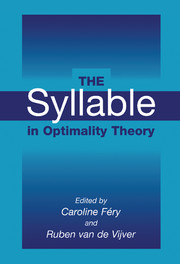Book contents
- Frontmatter
- Contents
- List of Contributors
- Preface
- The Syllable in Optimality Theory
- Part One INTRODUCTION
- Part Two SYLLABLE STRUCTURE AND PROSODIC STRUCTURE
- Part Three NONMORAIC SYLLABLES AND SYLLABLE EDGES
- 6 Syllables and Moras in Arabic
- 7 Semisyllables and Universal Syllabification
- 8 Onsets and Nonmoraic Syllables in German
- 9 Extrasyllabic Consonants and Onset Well-Formedness
- 10 Beyond Codas: Word and Phrase-Final Alignment
- Part Four SEGMENTS AND SYLLABLES
- Part Five HOW CONCRETE IS PHONOTACTICS?
- Author Index
- Languages Index
- Subject Index
10 - Beyond Codas: Word and Phrase-Final Alignment
Published online by Cambridge University Press: 03 July 2009
- Frontmatter
- Contents
- List of Contributors
- Preface
- The Syllable in Optimality Theory
- Part One INTRODUCTION
- Part Two SYLLABLE STRUCTURE AND PROSODIC STRUCTURE
- Part Three NONMORAIC SYLLABLES AND SYLLABLE EDGES
- 6 Syllables and Moras in Arabic
- 7 Semisyllables and Universal Syllabification
- 8 Onsets and Nonmoraic Syllables in German
- 9 Extrasyllabic Consonants and Onset Well-Formedness
- 10 Beyond Codas: Word and Phrase-Final Alignment
- Part Four SEGMENTS AND SYLLABLES
- Part Five HOW CONCRETE IS PHONOTACTICS?
- Author Index
- Languages Index
- Subject Index
Summary
Introduction
Cross-linguistically, syllable rhymes and codas are limited in both quantity and quality by constraints on length and sonority sequencing; the rhyme and coda also play a role in syllable weight and the resulting placement of stress (e.g., see Blevins 1995 and references therein). However, the use of the syllable alone to state phonotactics predicts that the segments permitted or required in word- and phrase-final positions match the segments permitted or required in syllable-final positions. If we base our phonotactics on word-internal codas, we find abundant counterevidence. Words and phrases can end in additional segments, in violation of sonority sequencing or outside the calculation of weight, and, conversely, word- and phrase-final edges can impose additional restrictions beyond those on syllable-final segments, so that the same range of syllable types is not found in all positions in a single language.
Optimality Theory (OT) allows for independent constraints on the edges of syllables and the edges of higher prosodic domains, such as words and phrases; factoring out the constraints on word and phrase edges will allow a clearer statement of the role of the syllable edge. In OT, syllable-final position can be constrained by alignment constraints (McCarthy and Prince 1993); for example, Align-R(σ,V) requires the right edge of a syllable to align with a vowel, thereby penalizing consonantal codas. In this chapter, I augment the typology based on such coda alignment constraints by adding alignment constraints referring to the prosodic word and phrase (Nespor and Vogel 1986, Wiltshire 1998).
- Type
- Chapter
- Information
- The Syllable in Optimality Theory , pp. 254 - 268Publisher: Cambridge University PressPrint publication year: 2003
- 3
- Cited by



